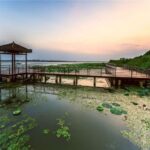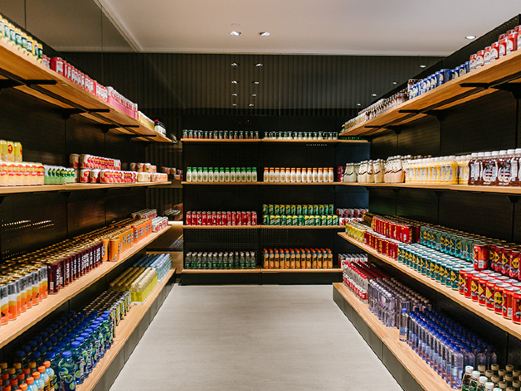Qionglong Mountain is located on the east bank of Taihu Lake in Suzhou. Its main peak, Ruomao Peak, has an altitude of 341.7 meters. The mountain road leads directly to the mountain. There are成片 forests on the mountain. The locals in Suzhou regard it as a natural large oxygen bar. Ancient celebrities such as Sun Wu left their footprints here. The scenic spots on the mountain also revolve around these celebrities.
Passing through small scenic spots such as Tiezuting, Cixiaoting, Shuangxi Spring, Tudici, and the mountain gate Dongtian of the original Shangzhenguan. It takes about 1-2 hours to reach the first major scenic spot on the mountain, Shangzhenguan. Shangzhenguan is a Taoist temple. It was built in the元始 years of Emperor Pingdi of the Han Dynasty. Later, it was repeatedly destroyed and rebuilt. Emperor Qianlong entered Shangzhenguan six times to pray for blessings. The Shangzhenguan seen now is newly built. There are many halls arranged according to the mountain topography from east to west. The walls are all painted red and the momentum is magnificent. There are many forks in the road here at Shangzhenguan. There is also a confusing six-way intersection. You need to carefully distinguish the directions. Walking to the left is Wanghuyuan. In the direction of Parking Lot No. 1 are Sunwuyuan and Zhumaichen’s Reading Platform. In the direction of Parking Lot No. 3 are the Bell and Drum Tower. In the downhill direction are Ningbang Temple and Wanyuetai. First go to Wanghuyuan. The area around Wanghuyuan, including Huancuilou and Wanghulou further inside, is a good place to overlook the scenery at the foot of the mountain. There are several viewing platforms along the way. The verdant mountain scenery is all in sight. It is said that Emperor Qianlong also overlooked the mountain scenery here. Then go to Sunwuyuan. This is a very important major scenic spot on the mountain. Sun Wu wrote ‘The Art of War’ here. In the depths of the dense forest that blocks out the sky, the winding brick and stone path leads to several thatched cottages. The bamboo fence and the gurgling spring flow into the stone well through bamboo tubes. It really looks like the secluded place of a martial arts master in martial arts novels. In the garden, there are also scenic spots such as the stone carving corridor of ‘The Art of War’ and the Bing Sheng Tang with the architectural style of the Spring and Autumn Period. In the tea room of Sunwuyuan, you can recall the scene of Sun Wu and his friends drinking tea and playing chess here in the past while tasting tea. Climbing up the steps is Zhumaichen’s Reading Platform. On a huge rock is engraved ‘The place where Zhu Gong, the governor of Kuaiji in the Han Dynasty, read books’, inscribed by Du Mu, a scholar in the Zhengde period of the Ming Dynasty. Zhumaichen, a minister in the Western Han Dynasty, was very poor before. He loved reading but was afraid of being laughed at. After secretly finishing reading a book on a huge rock, he hid the book under the rock. The town of Cangsang on the north side of Qionglong Mountain is named after him. Then return to the six-way intersection and walk in the direction of the Bell and Drum Tower. The Bell and Drum Tower belongs to Ningbang Temple’s building at a higher place. Going down to Ningbang Temple, the temple was built in the Liang Dynasty and rebuilt in the twelfth year of Shaoxing in the Southern Song Dynasty. It was originally called Haiyun Zen Temple. After Yue Fei was killed, Han Shizhong retired to Canglang Pavilion in Suzhou and often came to the temple to meditate. Because he still cared about the country, he changed the name of the temple to Ningbang Temple. What is worth seeing in the temple is the 18.8-meter-long imitation Tang colorful reclining Buddha in the Haiyun Zen Cave. Although it is newly made, it is very exquisite. There is also a fountain in front of the reclining Buddha that is the same as the Nine Dragons Bathing in Wuxi Lingshan Scenic Area, but it is much smaller.Continuing downwards, after visiting the Moon-Playing Terrace where Han Shizhong and his troops would worry about the country under the moonlight in their later years, one proceeds along the winding mountain road to exit the main gate of the scenic area. Throughout the tour of Qionglong Mountain, one can occasionally see cliff inscriptions, which add to the scenery. Unfortunately, the Ruo-Mao Peak has not yet been developed, making it impossible to truly reach the summit.
At the southeast foot of Qionglong Mountain, there is a newly built cultural attraction, the Sun Wu Cultural Park, and further east is the Bird Garden housing numerous birds. From the main entrance of the scenic area, take bus number 667 to the ‘Agricultural and Forestry Village Tanggangtou’ stop, walk 400 meters west to reach the Sun Wu Cultural Park; get off at the ‘Xiao Wang Mountain Scenic Area’ stop to arrive at the Bird Garden. If you have time, you can visit these two places; if not, it is not a necessity. There are dining options on the mountain, typically resolved at the Wanghu Garden Restaurant, but it is quite expensive. There is a row of snack shops in front of the Shangzhen Temple, vegetarian meals are available at Ningbang Temple, and near the main gate along the winding mountain road, there is Qionglong Restaurant where you can enjoy barbecue. It is recommended to bring some dry food to satisfy your hunger and then head to Cangshu Town to taste the local specialty, Cangshu lamb. Accommodation is available at Wanghu Garden on the mountain, but there is not much significance in staying overnight. Opening hours are from May 1st to September 30th, 08:30 to 17:00; from October 1st to April 30th, 08:30 to 16:30.
Preferential policies for children: Children aged 6 (inclusive) or under 1.4 meters (inclusive) in height can enter for free with valid identification; minors aged 6 (exclusive) to 18 (inclusive) can enter at half price with valid identification. Students: Full-time undergraduate and below students can enter at half price with valid identification. Elderly: Elderly aged 70 (inclusive) and above can enter for free with valid identification; those aged 60 (inclusive) to 70 (exclusive) can enter at half price with valid identification.

Additional information: The above information is for reference only; specific details are subject to the official announcements at the scenic area. Service facilities include guided tours: The scenic area offers manual guided services. Cost: 100 yuan per time. Working hours: 08:30-16:30. Restrooms: Qionglong Mountain has multiple restrooms located near the parking lot, ticket office, visitor center, scenic area square, Shangzhen Temple, Ningbang Temple, Sun Wu Garden, and Wanghu Garden, all marked with conspicuous signs.










